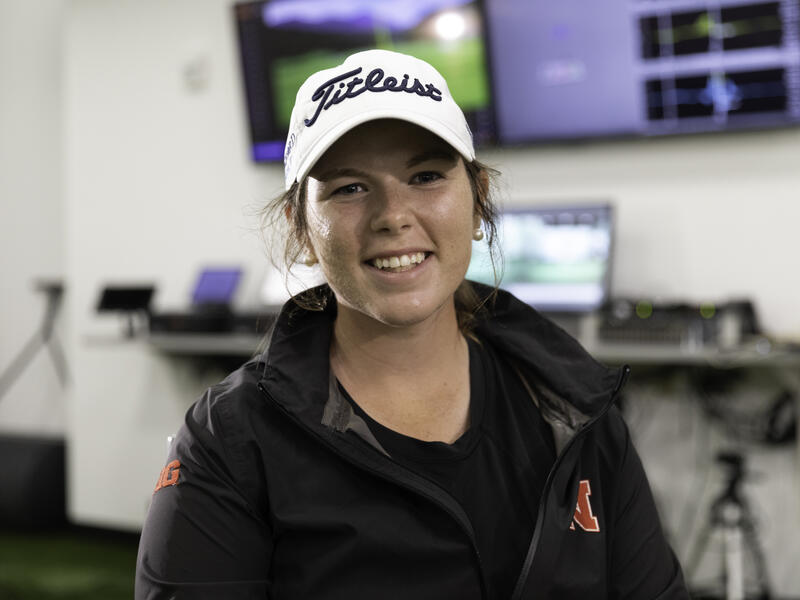Golf means a lot to Kate Smith. You can guess that by looking at her life and her background in the game or by the decisions she has made in trying to get better at it.
This Detroit Lakes, Minnesota, native just won the Big 10 women’s individual championship in April as a senior for the Nebraska Cornhuskers. She overwhelmed the competition with a closing-round 64 to win the tournament by three strokes. She’d began the day four strokes behind the leader.
With that rousing competitive highlight serving as a backdrop, she is now in the beginning stages of what she hopes will evolve into a career as an LPGA competitor.
She has decided that the Sanford POWER Golf Academy, with its three-tiered approach to improve at the game, is going to help her get there.
“Sanford has a lot of connections in my area of Detroit Lakes and the Fargo-Moorhead area so I heard a lot of great things,” said Smith, whose father Kris is a PGA teaching pro in Detroit Lakes and serves as Kate’s swing coach.
“I’ve worked with a lot of great players in the past and I know I’m going to have to elevate my game in order to make it to the Tour. So I’ve been looking for all the resources I can to get better and exceed my expectations.”
Science of the golf swing
Smith recently completed a day at the Sanford Sports Complex in Sioux Falls, South Dakota, that included a sweat test at the Sanford Sports Science Institute, and a biomechanics and movement assessment at the POWER Golf Academy. It included time with Matt Rollag, a senior physical therapist for Sanford POWER Sports Therapy, and Aaron Trunt, a senior biomechanical engineer for the Sanford Sports Science Institute.
It amounted to a deep-dive into how she hits the golf ball, followed by conversations about what she can do to get better at it.
“We did some 3D imaging of my swing as well as 2D imaging and then a baseline test about how my body moves,” Smith said. “We’ll be trying to connect those two pieces. I see my weaknesses, my strengths and mobility and how all that affects my swing. It was really informative — I’m excited to work on that in the future and take it into account when I’m practicing.”
One of the great advantages of the POWER Academy’s approach to improvement is that it works with players of all ages and skill levels. Golfers can always get better regardless of where the process begins.
“Amateur golfers receive the same exact treatment as the competitive players we work with in terms of coaching, assessments and technology,” Trunt said. “Whether we’re working with beginners or golfers at Kate’s level, we want to give them information about how their body moves that will provide them with value. We want to provide them with information they can work on going forward.”
Covering new ground
In Smith’s case, the Golf Academy is helping a player who has played the game her whole life and has had access to professional coaching since she first picked up a club. Even so, she and Trunt and Lundgren covered new ground throughout her visit.
“It’s the new age of golf — the science side and the distance side,” Smith said. “I’m always looking for new ways to get better. The staff has been very knowledgeable and helpful in sending me on a better path to work on the things I need to work on.”
Smith hits the ball farther off the tee than many LPGA players, Trunt said. One of the missions, then, is to hit it in the fairway more often — while also hitting the ball even farther.
“One thing we can do is not only add power but add consistency to her shots,” Trunt said. “That can make her even greater and bring her success on whatever Tour she plays.”
Combining skill work with sports science, physical therapy and strength and conditioning is the multifaceted cornerstone of the Golf Academy’s mission. Communication is a key in the delivery of all of them.
Smith, spending time with the Golf Academy team for the first time, picked up on that trait fairly quickly. After her day with the staff, she called her father, the golf teacher, and told him all about it.
“I think sometimes it’s tough being a female golfer because you get talked down to a lot,” Smith said. “Here, the staff is so kind — they really meet you where you’re at and understand that you’re trying to get better. They understand I’ve had some success, but where can that go next? It was great. I enjoyed the experience and I’m looking forward to coming back.”
Learn more
- LPGA great joins Sanford POWER Golf Academy team
- Sara Detlefsen is helping women and girls enjoy playing golf
- Podcast: Sanford International, from clinic to course
…
Posted In Allied Health, Detroit Lakes, Fargo, Golf, Sanford Sports, Sioux Falls, Sports Medicine

